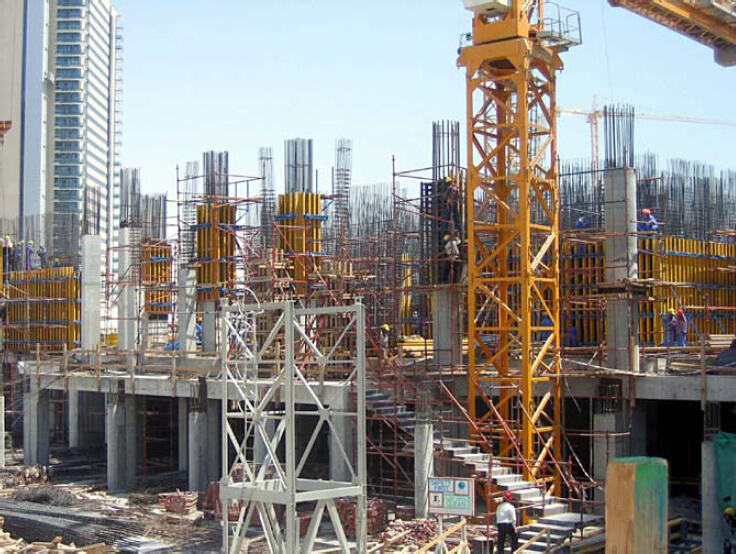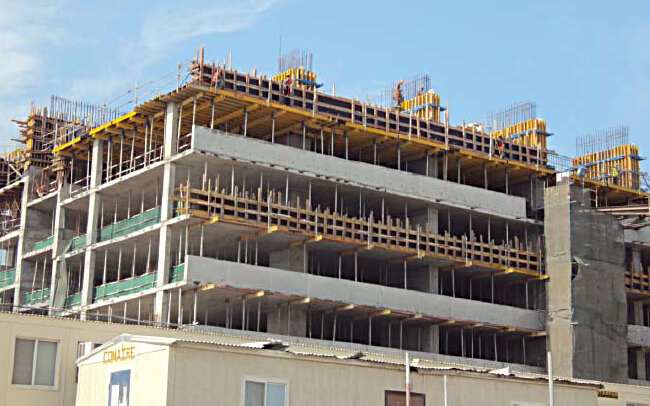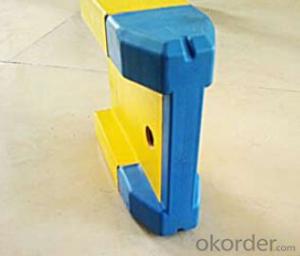Timber-beam Formwork for building Construction
- Loading Port:
- Tianjin
- Payment Terms:
- TT OR LC
- Min Order Qty:
- 50 m²
- Supply Capability:
- 1000 m²/month
OKorder Service Pledge
Quality Product, Order Online Tracking, Timely Delivery
OKorder Financial Service
Credit Rating, Credit Services, Credit Purchasing
You Might Also Like
Characteristics:
◆ Standardized production lines.
Supply capability: 3000m/day, Lmax = 6600mm.
◆ Finger jointing of the flange and web, the strength of timber beam is highly improved.
Max. shearing force failure load:40KN
◆ Well treated to prevent from water penetration or erosion, so the service life maximally
extended.
Normally, CNBM timber beam H20 can be used for 4 to 5 years, the exact using time would
depend on maintenance & storage.
◆ Robust caps at the end of the girders protect against damages.


- Q:How is steel formwork assembled and disassembled?
- Efficient construction processes are ensured by systematically and sequentially assembling and disassembling steel formwork. The foundation preparation marks the start of the assembly process, where the steel formwork components are arranged to match the desired shape and dimensions of the structure. To assemble the steel formwork, the first step involves connecting the vertical and horizontal components using various connecting devices like pins, bolts, or clips. These components, including panels, walers, and soldiers, are interlinked to create a rigid framework that offers the necessary support and shape for the concrete structure. Once the initial framework is assembled, the next step includes placing form ties or clamps that firmly secure the formwork panels in place. These ties or clamps are inserted through holes in the panels and tightly fastened on the opposite side to prevent any movement during the pouring and curing of the concrete. After the concrete has been poured and cured, the disassembly process begins. This process is carried out in reverse order, starting with removing the form ties or clamps. Once these are taken out, the formwork panels can be easily detached from the framework, allowing for the removal of the soldiers and walers. The disassembly of steel formwork also involves carefully dismantling the vertical and horizontal components, ensuring no damage is done to the framework or the panels. This is achieved by removing the connecting devices, such as pins, bolts, or clips, and systematically disassembling the various components. It is crucial to note that only experienced and trained professionals should handle the assembly and disassembly of steel formwork to guarantee safety and avoid any potential accidents or structural failures. Adhering to proper procedures and guidelines is essential for the successful completion of a construction project that utilizes steel formwork.
- Q:What are the common safety measures to be followed when using steel formwork?
- When using steel formwork, there are several common safety measures that should be followed to ensure the safety of workers and the overall success of the construction project. These measures include: 1. Proper training and education: All workers involved in using steel formwork should receive proper training on its installation, use, and dismantling. They should be aware of the potential hazards and how to mitigate them. 2. Inspection and maintenance: Before using steel formwork, it is crucial to inspect it for any defects or damage. Any issues should be promptly addressed or the formwork should be replaced. Regular maintenance should also be carried out to ensure its structural integrity. 3. Proper handling and storage: Steel formwork should be handled with care to prevent any injuries. It should be stored in a designated area, away from any potential hazards or heavy machinery. 4. Use of personal protective equipment (PPE): Workers should always wear appropriate PPE, such as safety helmets, safety goggles, gloves, and safety shoes, to protect themselves from any potential hazards or falling objects. 5. Adequate bracing and support: Steel formwork should be properly braced and supported to prevent any collapse or structural failure. This includes using the right number and type of props or supports, as well as ensuring the formwork is level and plumb. 6. Secure and stable footing: Workers should have a secure and stable footing when working with steel formwork. This may require the use of scaffolding or temporary platforms to provide a safe working surface. 7. Proper lifting techniques: When lifting or moving steel formwork, workers should use proper lifting techniques to prevent strains or injuries. This may involve using lifting equipment, such as cranes or hoists, and ensuring the load is evenly distributed. 8. Adequate communication and coordination: Clear communication and coordination among workers is essential when using steel formwork. This helps to prevent accidents and ensures that everyone is aware of their roles and responsibilities. By following these common safety measures, the risk of accidents or injuries when using steel formwork can be significantly reduced, creating a safer and more productive work environment.
- Q:How does steel formwork contribute to the overall sustainability of the construction industry?
- There are several ways in which steel formwork contributes to the overall sustainability of the construction industry. Firstly, its durability and long-lasting nature allow for multiple reuses, reducing the need for new formwork materials each time a construction project is undertaken. This, in turn, significantly reduces waste generation during the construction process and minimizes the industry's overall environmental impact. In addition, steel formwork offers a more sustainable alternative to traditional materials like timber. The use of timber often involves cutting down trees, leading to deforestation and habitat destruction. By opting for steel formwork, we can decrease our reliance on timber and contribute to the preservation of forests. Moreover, steel formwork provides greater structural stability and strength compared to other materials. This enables more efficient construction processes and reduces the necessity for additional support structures. Consequently, less material is wasted, energy is conserved, and the overall construction time is shortened, resulting in a more sustainable process. Furthermore, steel formwork exhibits exceptional resistance to weather conditions, corrosion, and fire. This ensures the longevity of buildings, thus reducing the need for frequent repairs or replacements. By utilizing steel formwork, we can construct structures with extended lifespans, leading to reduced resource consumption and waste generation over time. Lastly, steel formwork is recyclable. At the end of its lifecycle, it can be easily melted down and repurposed for other applications. This diminishes the demand for new steel production, conserves natural resources, and lowers energy consumption. To sum up, steel formwork's durability, reusability, resistance to weather conditions, and recyclability all contribute to the overall sustainability of the construction industry. By minimizing waste generation, deforestation, energy consumption, and resource depletion, its use proves to be an environmentally-friendly choice for construction projects.
- Q:Types of building templates? What is clear water template?
- Wood plywood (water templates): currently widely used in the solid wood plywood formwork, should promote the use of wood covered plywood. Commonly used in Guangdong area of Eucalyptus wood membrane.
- Q:How does steel formwork affect the overall project coordination and scheduling?
- Steel formwork can have a significant impact on the overall project coordination and scheduling. Firstly, steel formwork is known for its durability and strength, allowing it to withstand the pressure and weight of concrete pouring. This means that construction can progress at a faster pace, minimizing delays and ensuring that the project remains on schedule. Furthermore, steel formwork offers a high level of accuracy and precision in creating the desired shapes and dimensions of the concrete structures. This precision reduces the need for rework and adjustments, saving time and preventing schedule disruptions. In terms of project coordination, steel formwork allows for better communication and collaboration between different teams involved in the construction process. The standardized and modular nature of steel formwork ensures that all parties are working with the same materials and dimensions, facilitating smoother coordination and reducing conflicts. Additionally, steel formwork is reusable, which means that it can be dismantled and used for multiple projects. This not only reduces the cost of materials but also improves project scheduling by allowing for concurrent construction activities. The ability to reuse steel formwork also minimizes the environmental impact of construction projects, aligning with sustainable practices. Overall, steel formwork enables better project coordination and scheduling by providing durability, accuracy, and reusability. Its efficiency and versatility contribute to faster construction timelines, reduced rework, and improved communication among various project stakeholders.
- Q:Can steel formwork be used for staircase construction?
- Indeed, steel formwork is perfectly suitable for the construction of staircases. This versatile and resilient material is frequently employed in construction ventures, including staircase construction. It furnishes a robust and secure framework for pouring concrete and guarantees the meticulous and precise formation of the staircase. Moreover, steel formwork can be reused, rendering it a cost-effective option for repetitive construction procedures such as staircase construction. Furthermore, it offers adaptability in terms of design, enabling the creation of diverse staircase shapes and dimensions. In summary, steel formwork is an ideal selection for staircase construction due to its potency, durability, reusability, and design flexibility.
- Q:What are the different sizes and dimensions available for steel formwork panels?
- Steel formwork panels are available in various sizes and dimensions to suit different construction needs. The most common sizes for steel formwork panels are 1.2 meters by 2.4 meters and 1.5 meters by 3 meters. These sizes are widely used in the construction industry due to their versatility and efficiency. The thickness of steel formwork panels can vary depending on the required load-bearing capacity and durability. Typically, steel formwork panels range from 12mm to 18mm in thickness. Thicker panels are often preferred for heavy-duty applications, while thinner panels are suitable for lighter loads. In addition to the standard sizes, custom sizes and dimensions can also be manufactured to meet specific project requirements. This flexibility allows contractors to tailor the formwork panels to their unique construction needs, ensuring optimal performance and efficiency on the job site. It is important to note that the sizes and dimensions of steel formwork panels may vary between manufacturers. Therefore, it is essential to consult with the supplier or manufacturer to determine the available sizes and dimensions for a specific product line. This will ensure that the chosen steel formwork panels are suitable for the intended application and meet the necessary structural requirements.
- Q:How does steel formwork handle different concrete setting time requirements?
- Steel formwork is highly versatile and can easily accommodate different concrete setting time requirements. It provides a rigid and sturdy framework that supports the concrete during the setting process. The steel formwork allows for precise shaping and molding of the concrete, enabling it to take various forms and designs. Additionally, steel formwork offers adjustable features, such as adjustable joints and connectors, which allow for quick assembly and disassembly, making it efficient in meeting different concrete setting time requirements. Overall, steel formwork provides a reliable and adaptable solution for handling different concrete setting time requirements.
- Q:What are the common design considerations for steel formwork in hot climates?
- When designing steel formwork for utilization in hot climates, there are various common factors that must be considered. 1. Thermal Expansion: Steel possesses a high coefficient of thermal expansion, implying that it expands and contracts with temperature fluctuations. In hot climates, where temperatures can reach exceptionally high levels, it is crucial to account for this expansion in the formwork's design. Sufficient provision for expansion joints and allowances should be made to accommodate the thermal movement of the steel. 2. Heat Resistance: Steel formwork should be designed to endure elevated temperatures without experiencing significant deformation or loss of strength. This may involve the selection of steel grades with superior heat resistance or the implementation of additional cooling measures to prevent overheating. 3. Corrosion Protection: Hot and humid climates can expedite the corrosion process, necessitating the incorporation of effective corrosion protection measures in the design. This can be achieved through the utilization of corrosion-resistant coatings, such as galvanization or epoxy coatings, or by integrating sacrificial anodes to safeguard the steel against corrosion. 4. Ventilation: Hot climates typically necessitate adequate ventilation to prevent the accumulation of heat and moisture within the formwork. Appropriately designed openings and vents should be included to facilitate air circulation and avert the formation of condensation, which can lead to corrosion and diminish the formwork's lifespan. 5. Insulation: In exceedingly hot climates, insulation can assist in minimizing the transfer of heat to the formwork, thereby reducing the impact of thermal expansion and diminishing the risk of deformation. Insulation materials, such as foam or reflective coatings, can be employed to create a barrier between the steel formwork and the external environment. 6. Durability: The design of steel formwork should account for the long-term durability requirements of the project. This includes the selection of materials and construction methods that exhibit resistance to degradation caused by UV radiation, extreme temperatures, and other environmental factors commonly encountered in hot climates. In summary, the design of steel formwork for use in hot climates necessitates careful consideration of thermal expansion, heat resistance, corrosion protection, ventilation, insulation, and durability. By addressing these factors, the formwork can endure the challenges posed by hot climates and ensure the successful completion of construction projects.
- Q:How does steel formwork improve the quality of concrete structures?
- Steel formwork is widely employed in the construction industry due to its numerous advantages, which greatly enhance the quality of concrete structures. Here are several ways in which steel formwork improves the quality of concrete structures: 1. Superior Form Stability: Compared to traditional wooden formwork, steel formwork offers enhanced form stability. It is more rigid and less prone to warping or distortion, guaranteeing that the concrete is poured into an accurate and consistent shape. This results in straighter walls, smoother surfaces, and overall better structural integrity. 2. Increased Durability: Steel formwork is highly durable and capable of withstanding the harsh conditions of construction sites. Unlike wooden formwork, it does not rot, decay, or easily sustain damage. Its long lifespan allows for multiple reuses, thereby reducing costs and waste. This durability translates into stronger and longer-lasting concrete structures. 3. Precise Dimensions: Steel formwork is manufactured with high precision, enabling accurate and consistent dimensions in concrete structures. It facilitates achieving the desired shape, size, and alignment of elements. This accuracy is crucial in ensuring that the structure meets required specifications and architectural designs, resulting in a high-quality finished product. 4. Improved Surface Finish: Steel formwork provides a smooth and even surface finish to concrete structures. The design of steel panels minimizes surface imperfections and prevents leakage of the concrete mixture. This results in visually appealing structures with uniform finishes, which reduces the need for additional plastering or finishing work. 5. Enhanced Safety: Steel formwork enhances safety during the construction process. Its sturdy and rigid nature provides a stable platform for workers to pour and work with concrete. The risk of accidents, such as formwork failure or collapse, is significantly reduced with steel formwork, ensuring the safety of workers and the integrity of the structure. In conclusion, the utilization of steel formwork in concrete construction brings multiple benefits that contribute to the improvement of structure quality. With its form stability, durability, precise dimensions, improved surface finish, and enhanced safety, steel formwork plays a vital role in ensuring the integrity, aesthetics, and longevity of concrete structures.
1. Manufacturer Overview |
|
|---|---|
| Location | |
| Year Established | |
| Annual Output Value | |
| Main Markets | |
| Company Certifications | |
2. Manufacturer Certificates |
|
|---|---|
| a) Certification Name | |
| Range | |
| Reference | |
| Validity Period | |
3. Manufacturer Capability |
|
|---|---|
| a)Trade Capacity | |
| Nearest Port | |
| Export Percentage | |
| No.of Employees in Trade Department | |
| Language Spoken: | |
| b)Factory Information | |
| Factory Size: | |
| No. of Production Lines | |
| Contract Manufacturing | |
| Product Price Range | |
Send your message to us
Timber-beam Formwork for building Construction
- Loading Port:
- Tianjin
- Payment Terms:
- TT OR LC
- Min Order Qty:
- 50 m²
- Supply Capability:
- 1000 m²/month
OKorder Service Pledge
Quality Product, Order Online Tracking, Timely Delivery
OKorder Financial Service
Credit Rating, Credit Services, Credit Purchasing
Similar products
New products
Hot products






















